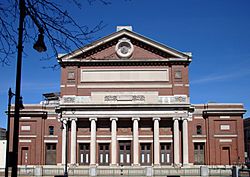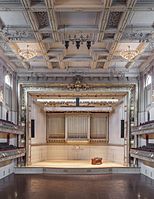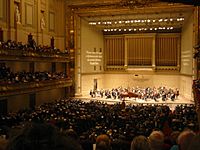Symphony Hall, Boston facts for kids

Symphony Hall from the south, 2007.
|
|
| Address | 301 Massachusetts Avenue |
|---|---|
| Location | Boston, Massachusetts, U.S. |
| Coordinates | 42°20′34.2″N 71°5′8.5″W / 42.342833°N 71.085694°W |
| Public transit | Symphony |
| Owner | Boston Symphony Orchestra |
| Type | concert hall |
| Capacity | 2,625 |
| Construction | |
| Broke ground | June 12, 1899 |
| Built | 1900 |
| Opened | October 15, 1900 |
|
Symphony Hall
|
|
| Architect | McKim, Mead and White |
| Architectural style | Renaissance |
| NRHP reference No. | 99000633 |
| Significant dates | |
| Added to NRHP | January 20, 1999 |
| Designated NHL | January 20, 1999 |
Symphony Hall is a famous concert hall in Boston, Massachusetts. It opened in 1900. The building was designed by the company McKim, Mead and White. It was built for the Boston Symphony Orchestra, which still performs there today.
Symphony Hall can hold 2,625 people. In 1999, it became a U.S. National Historic Landmark. Many people say it is one of the top three concert halls in the world for its amazing sound. It is often called the best in the United States. The hall is also home to the Boston Pops Orchestra. Many other concerts, like those by the Handel and Haydn Society, are held there too.
Contents
History and Design of Symphony Hall
On June 12, 1899, work began on Symphony Hall. The Boston Symphony Orchestra needed a new home. Their old building was going to be affected by new roads and subway lines. The new hall was finished in just 17 months. It cost $771,000 to build.
The first concert in Symphony Hall was on October 15, 1900. The architects, McKim, Mead and White, worked with Wallace Clement Sabine. He was a young physics professor from Harvard University. He helped design the hall using scientific rules for sound. This made Symphony Hall one of the first concert halls ever designed this way.
People have always loved how clear the sound is in the hall. It is known as one of the best places in the world for classical music.
Building Style and Sound
Symphony Hall looks like the second Gewandhaus concert hall in Leipzig, Germany. That hall was later destroyed in World War II. Symphony Hall has a rectangular "shoebox" shape. This is like other famous halls such as the Concertgebouw in Amsterdam and the Musikverein in Vienna.
The hall is about 18.6 meters (61 feet) high. It is 22.9 meters (75 feet) wide. It is 38.1 meters (125 feet) long from the back wall to the stage. The walls of the stage tilt inward. This helps to focus the sound.
The hall is mostly made of brick, steel, and plaster. Only the floors are made of wood. The side balconies are not very deep. This stops them from trapping or muffling the sound. The special ceiling and statues along the walls also help the sound reach every seat perfectly.
Stage Floor Update
In 2006, the original stage floor was replaced. It had been used for many years. The new floor cost $250,000. To keep the sound the same, the new floor was built exactly like the old one. It used the same wood and building methods. Even the nails were hammered in by hand, just like in 1900.
The name of the famous composer Ludwig van Beethoven is written above the stage. He is the only musician whose name appears in the hall. The leather seats in the hall are also the original ones from 1900. The hall can seat 2,625 people during the Symphony season. During the Pops season, it seats 2,371 people, with 800 seats at tables on the main floor.
Statues in the Hall
There are sixteen copies of famous Greek and Roman statues along the upper walls of Symphony Hall. Ten of them show mythical figures. Six show historical people. All these copies were made by P. P. Caproni and Brother.
Here are some of the statues you can see:
- On the right side, near the stage:
- A Faun carrying the boy Bacchus.
- Apollo Citharoedus, a Roman god playing a lyre.
- A Young Woman from Herculaneum.
- A Dancing Faun.
- Demosthenes, a famous Greek speaker.
- A Seated Anacreon, a Greek poet.
- A statue of a tragic poet with the head of Euripides.
- Diana of Versailles, a Roman goddess of the hunt.
- On the left side, near the stage:
- A Resting Satyr.
- A Wounded Amazon warrior.
- Hermes Logios, a Greek god.
- Lemnian Athena, a Greek goddess.
- The Lateran Sophocles, a Greek writer.
- A Standing Anacreon.
- Aeschines, a Greek speaker.
- Apollo Belvedere, a famous Roman statue of Apollo.
The Symphony Hall Organ
The organ in Symphony Hall has 4,800 pipes! It is an Aeolian-Skinner organ. It was designed by G. Donald Harrison and put in place in 1949. The famous musician Albert Schweitzer even signed it.
This new organ replaced the hall's first organ, which was built in 1900. The old organ had almost 4,000 pipes. By the 1940s, people wanted a lighter, clearer sound from organs. The new 1949 organ reused many of the old pipes. It also added 600 new pipes.
In 2003, the organ was completely updated by Foley-Baker Inc. They kept many of the original parts and pipes. They also added new sections to the organ for better sound. The old four-manual keyboard was replaced with a smaller three-manual one. This helps the organist see the conductor better when they play together.
See also
 In Spanish: Symphony Hall para niños
In Spanish: Symphony Hall para niños



